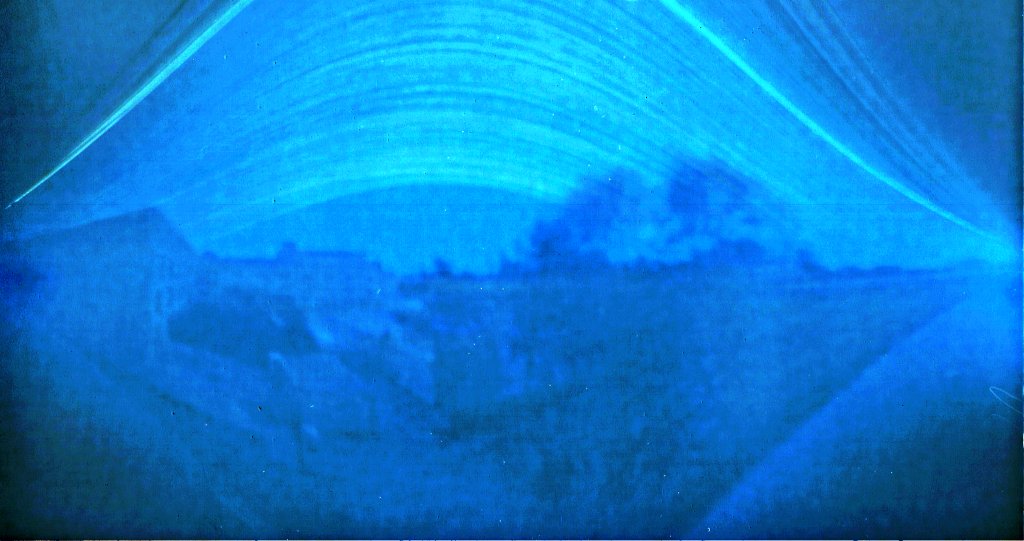
A solargraph captured by a pinhole camera with a very long exposure displays the daily path of the sun over the course of two years of the pandemic lockdown. Credit: Wayne Chan
Pinhole camera captures passage of time during pandemic
When the pandemic forced most of us into lockdown in March 2020, even the UM campuses became quiet as staff and faculty began working from home.
But a forethinking staff member in the Centre for Earth Observation Science had an idea that ended up recording the stillness of human activity while the universe kept functioning, undashed by any virus.
Wayne Chan created a pinhole camera and just as the pandemic lockdown started he set it up in the window of the Wallace building before he left, thinking that he would retrieve it once the pandemic was over. But then the pandemic kept going, and going, and finally after more than two years away from the office he went in and discovered the result once restrictions were eased.
His rudimentary science project produced a solargraph that showed the passage of the sun over the Parker and Allen buildings throughout the two years of the pandemic lockdown on the Fort Garry campus. The image is an interesting and unique record of the pandemic and its effects on UM.
Here is Chan’s personal reflection on his effort:
The sun’s daily journey east to west across the sky usually leaves no traces of itself. It occurs every day and we usually pay scarce attention to it. But its diurnal rhythms over weeks and months can be recorded, not as a video or a sequence of still images, but as a single image.
The accompanying image is a solargraph, captured by a pinhole camera with a very long exposure. It displays the daily path of the sun over the course of two years. The camera was installed in a CEOS office at the UM Fort Garry campus as the initial COVID-19 wave began to sweep through the province.
Each arc is the sun’s east-to-west trail for one day. The highest and lowest arcs in the sky occurred on the summer and winter solstices, respectively. Gaps within an arc represent times when the sun was obscured by clouds. Only objects with some permanence appear in these images. Buildings, roads and trees are present, but people and vehicles are not, unless they were stationary for long periods of time.
Pinhole photography is one of the oldest and most basic forms of photography. It doesn’t require a lens, just a small pinhole in the side of a light-proof box or cylinder. In this particular case, the pinhole camera was made from a drink can with a small hole in the side and a sheet of photographic paper inside. The can was placed on a windowsill with the pinhole facing south.
When the camera was installed on March 23, 2020, there were 20 Covid-19 cases in Manitoba, with most related to travel. No deaths from the virus had been recorded yet. Over the next 730 days, it bore silent witness to the pandemic, even as the campus stood nearly deserted. Day after day, through lockdowns and periodic reopenings, the sunlight seeping through the camera’s pinhole interacted with the silver halide of the photographic paper, etching indelible curves upon it.
When the sun’s arc reached its maximum height on the first day of summer during that first year of Covid-19, the case count had increased to 313, with seven deaths. The cases continued to climb as the days receded. By the time the sun’s path reached its lowest point in the sky on December 21, 2020, many more people had lost their lives.
The dawn of 2021 saw new hope as much-anticipated vaccines began to be rolled out. However, by mid-spring, when the sun’s trail was three quarters of the way to its annual apex, cases peaked again when the Delta variant hit.
A comparatively quiet summer followed, where the number of daily cases were usually under a hundred. Just as we were beginning to think that the finish line was in sight, the count began to creep upwards again as we edged towards fall. We were then struck swiftly by the new highly infectious omicron variant.
The pinhole camera was removed on March 23, 2022, exactly two years to the day it was installed. Pandemic restrictions were being eased, fueling the start of a new wave driven by the BA.2 subvariant. The total tally of COVID cases in Manitoba on that date was 134,554, with 1,735 lives lost.
Early in the pandemic, people placed pictures of rainbows in their windows as a sign of hope and togetherness. But as weeks turned to months, hope faded and togetherness often devolved into divisiveness.
However, today, in the summer of 2022, after many months and innumerable variants and subvariants later, there is guarded optimism. It is a sentiment expressed by an old, obscure word called respair, which means a return to hope after a period of despair.
Perhaps the solargraph can be seen as a kind of rainbow reflecting this. A rainbow forged by sunrises and sunsets. A rainbow not of naive hope, but of hard-earned hope after its loss.






